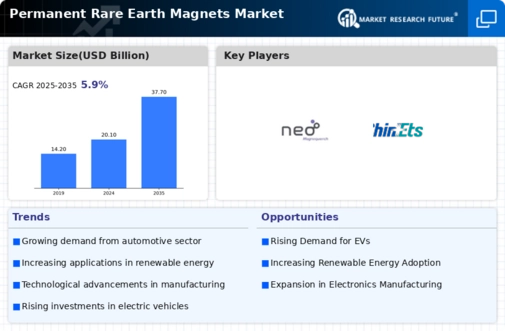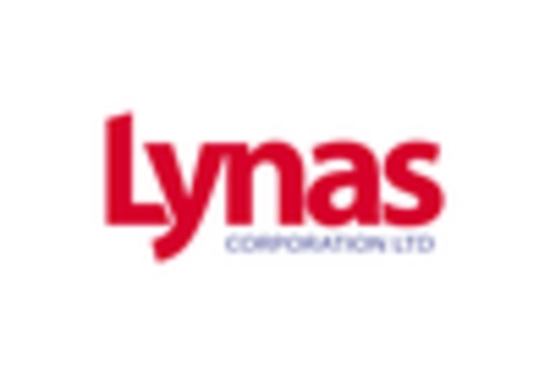Rising Demand in Electronics
The Permanent Rare Earth Magnets Market is experiencing a notable surge in demand, particularly within the electronics sector. As consumer electronics continue to evolve, the need for compact and efficient components has become paramount. Permanent rare earth magnets, known for their superior magnetic strength and miniaturization capabilities, are increasingly utilized in devices such as smartphones, laptops, and electric vehicles. Recent data indicates that the electronics segment accounts for a substantial portion of the market, with projections suggesting a growth rate of approximately 8% annually. This trend underscores the critical role that permanent rare earth magnets play in enhancing the performance and efficiency of modern electronic devices.
Growth in Renewable Energy Sector
The Permanent Rare Earth Magnets Market is significantly influenced by the expansion of the renewable energy sector. Wind turbines and electric motors, which are integral to renewable energy generation, rely heavily on high-performance magnets for optimal efficiency. The increasing global emphasis on sustainable energy solutions has led to a heightened demand for permanent rare earth magnets, as they are essential for the production of powerful and efficient generators. Market analysis indicates that the renewable energy segment is projected to grow at a rate of 10% over the next five years, further solidifying the importance of permanent rare earth magnets in the transition towards cleaner energy sources.
Automotive Industry Transformation
The Permanent Rare Earth Magnets Market is witnessing transformative changes driven by the automotive sector's shift towards electrification. As electric vehicles (EVs) gain traction, the demand for high-performance magnets is escalating. Permanent rare earth magnets are crucial components in electric motors, contributing to the overall efficiency and performance of EVs. Recent statistics reveal that the electric vehicle market is expected to grow at a compound annual growth rate of 15% through 2030, which will likely bolster the demand for permanent rare earth magnets. This trend indicates a pivotal moment for the industry, as automakers increasingly prioritize the integration of advanced magnet technologies in their designs.
Technological Innovations in Manufacturing
The Permanent Rare Earth Magnets Market is benefiting from ongoing technological innovations in manufacturing processes. Advances in production techniques, such as additive manufacturing and improved sintering methods, are enhancing the quality and efficiency of magnet production. These innovations not only reduce costs but also enable the creation of more complex and high-performance magnet designs. As manufacturers adopt these cutting-edge technologies, the market is likely to see an increase in the availability of customized solutions tailored to specific applications. This shift may lead to a more competitive landscape, as companies strive to differentiate themselves through superior product offerings.
Increased Investment in Research and Development
The Permanent Rare Earth Magnets Market is experiencing a surge in investment directed towards research and development initiatives. Companies are increasingly recognizing the potential of permanent rare earth magnets in various applications, prompting them to allocate resources for innovation. This focus on R&D is expected to yield advancements in magnet performance, sustainability, and cost-effectiveness. Furthermore, government support for research initiatives in advanced materials is likely to enhance the industry's growth prospects. As new applications and technologies emerge, the market may witness a diversification of product offerings, catering to a broader range of industries and applications.


















Leave a Comment